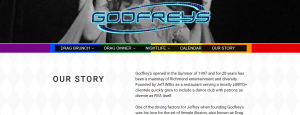For this post, I will continue my analysis of the Godfrey’s website with a specific focus on their “Our Story” page. This can be found at the following address: http://godfreysva.com/our-story/

Rhetorical Situation:
- Current attitudes about the LGBTQ+ community offer both opportunities and challenges for Godfrey’s. The lack of acceptance of LGBTQ+ lifestyles in the American south (and beyond) results in members of these communities feeling rejected and isolated. Some may even feel that visiting a place like Godfrey’s is a risk to their safety based on events like the Pulse Nightclub shooting of 2016. In this midst of this tension, Godfrey’s enters the market as a safe space for members of the LGBTQ+ community to come together, express themselves, and enjoy fun performances and other events. Godfrey’s utilizes the opportunity created within this context to a degree, particularly when they assert that Godfrey’s allows visitors of 18 years old and over because they “believe that our youth are so vulnerable to self-doubt and low self-worth that RVA needs a space where young people can come together in an environment that is inclusive and safe regardless of their sexuality or gender identity. We hope Godfrey’s is that space.” Despite this, Godfrey’s could expand upon their efforts of inclusion on their website with specific references to contemporary attitudes about LGBTQ+ individuals (both positive and negative). This would add credibility to the organization and imply a level of urgency about the situation at hand.
- Functional audiences and normative audiences are the most appropriate target in this situation. Functional audiences, which “help the organization function on a day-to-day basis,” would consist of prospective and current customers (Ford & Hoffman 66). Additionally, normative audiences, which “are composed of individuals in organizations that face similar challenges,” are also relevant in Godfrey’s website (Ford & Hoffman 66). Their rhetoric addresses these audiences because it entices them to visit the club and creates a sense of solidarity among other organizations which, like Godfrey’s, strive to provide safe spaces for members of marginalized communities.
- The current political climate of the American south (which encompasses Godfrey’s location in Richmond, Virginia) might make it more difficult for them to answer the exigencies because many conservatives reject the LGBTQ+ community and their expression through means like drag performances at Godfrey’s.
Issues:
- The organization portrays itself as qualified to speak about LGBTQ+ issues by noting their founding in 1997 and their status as “a mainstay of Richmond entertainment and diversity.” These statements build Godfrey’s credibility because they assert that they have support in their communities and have acquired wisdom on the topic throughout their 20 years of business.
- Godfrey’s “Our Story” page does not reflect the voices of functional audiences; however, they illustrate the influence of normative audiences because they assert that some of their events reflect the needs of charitable organizations. They state that “From Breast Cancer, to the Victims of the Massacre at Pulse, Orlando, giving back are some of the most rewarding experiences that we have. We thank everyone that have contributed to success of these events.” Here, Godfrey’s notes the influential nature of normative audiences on their events.
- Their “Our Story” page states, “Godfrey’s has had many successes and challenges over the years, but through it all we have strived to be a place of diversity, inclusion, and just plain fun for the RVA community.” This declaration implies that Godfrey’s previously dealt with issues related to their status as an LGBTQ+-friendly organization; however, they provide no further details on this important background information.
- Godfrey’s appears to conceal and de-emphasize information when they refrain from giving details about the hardships which they endured. Describing these issues might build credibility by showing the organization’s ability to overcome.